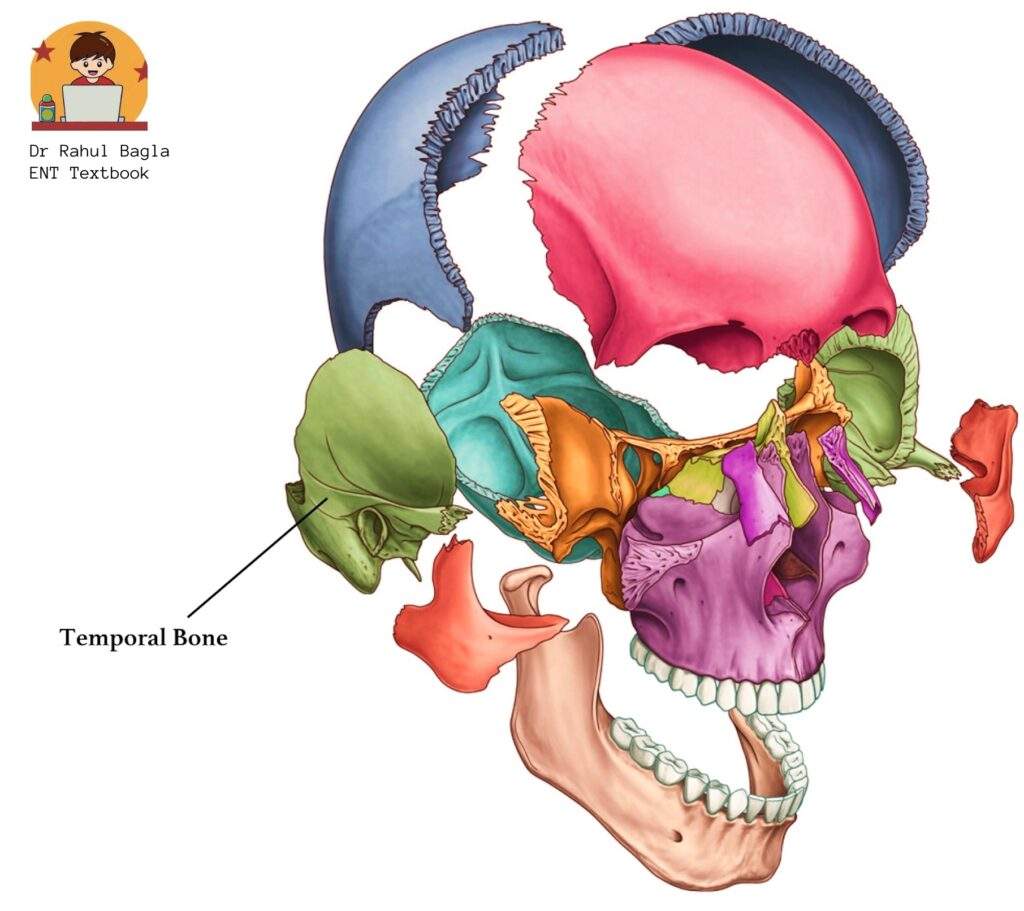
Anatomy of Temporal Bone. The temporal bone is a paired symmetrical bone which forms the lower lateral walls of the human skull. It also forms parts of middle & posterior cranial fossa and base of skull. The temporal bone lies between the greater wing of sphenoid bone anteriorly and the occipital bone posteriorly. The body of sphenoid bone lies between the paired temporal bones. It articulates inferiorly with the mandible, forming the synovial temporo-mandibular joint of the jaw.
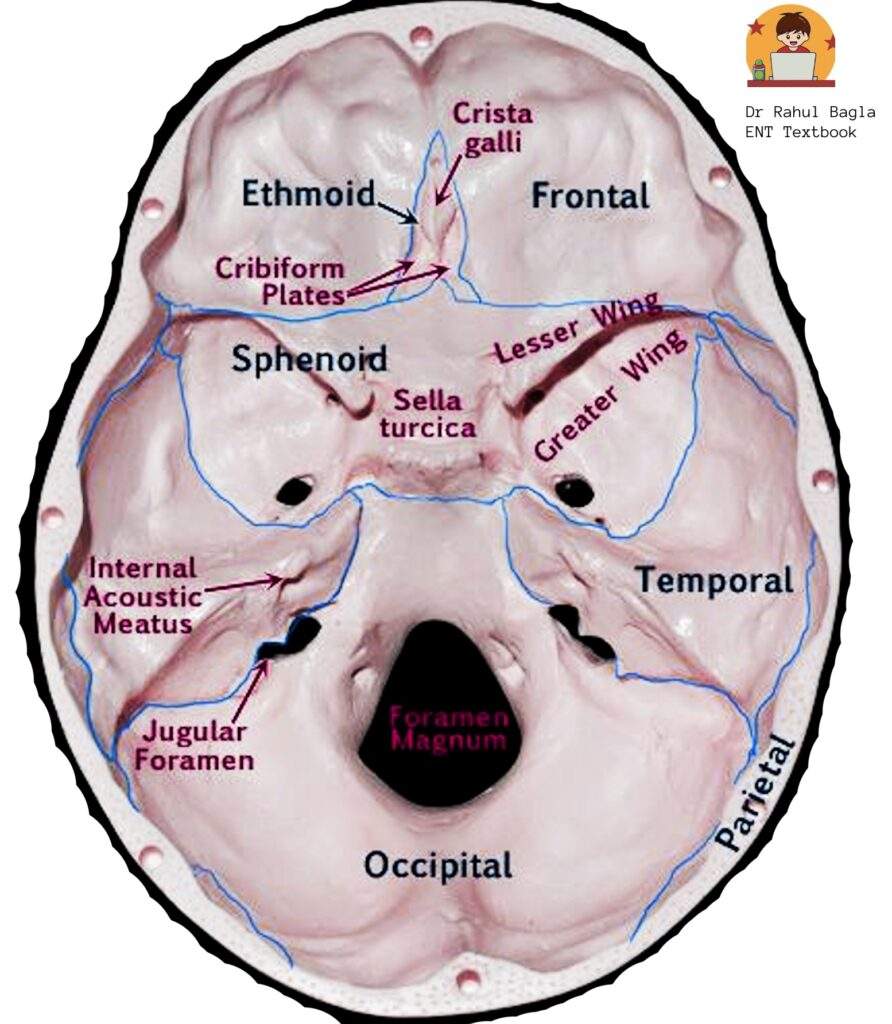
The greater wing of sphenoid, parietal and frontal bones together with squamous part of temporal bone form the pterion, which is the weakest part of the skull. Temporal bone contains important structures of the vestibulocochlear apparatus, including the external auditory canal, the middle ear and the structures forming the inner ear.
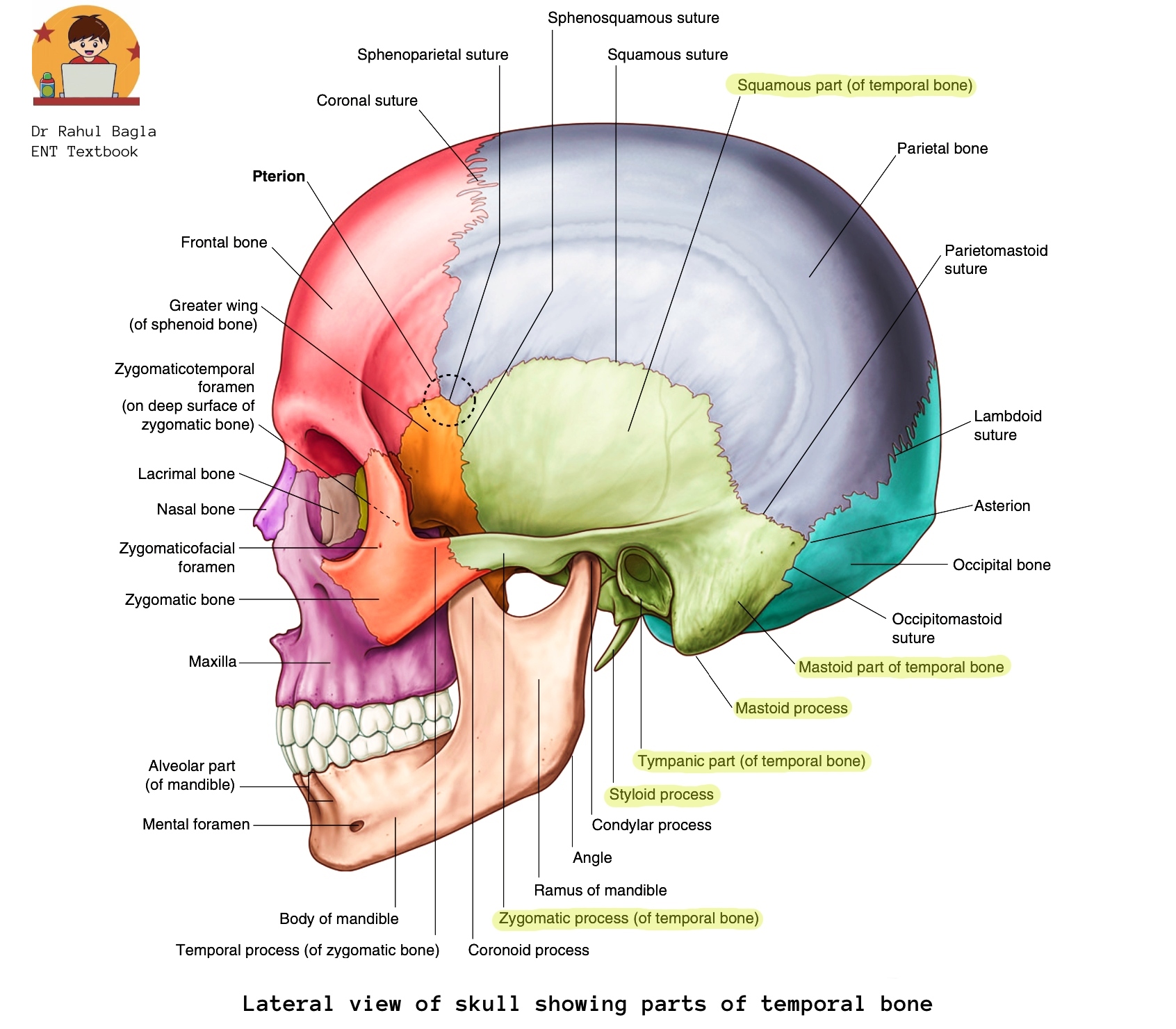
Parts of temporal bone. It is a composite structure consisting of five parts, each ossifying independently and later fuses with each other.
- Squamous
- Petrous
- Mastoid
- Tympanic
- Styloid.
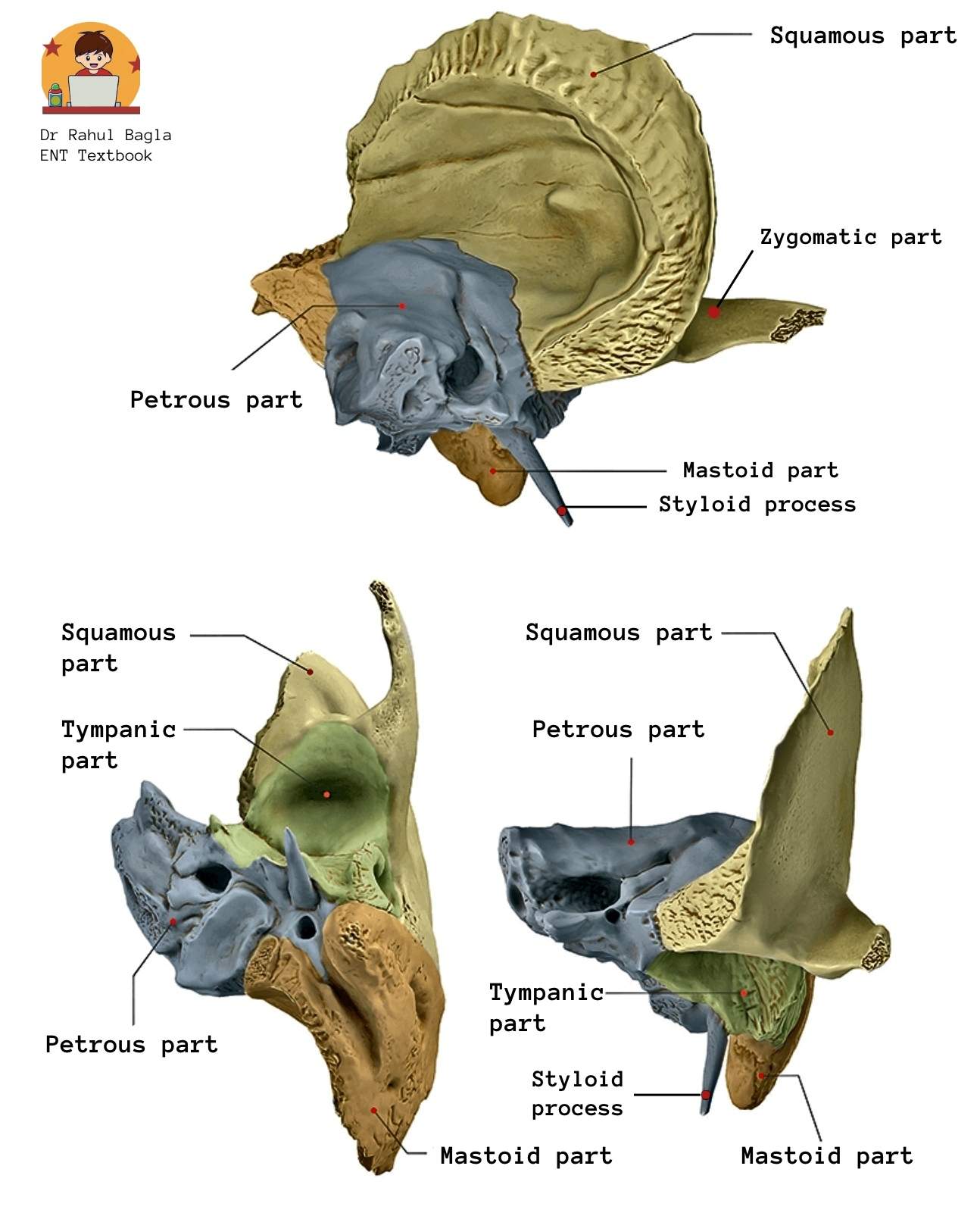
Squamous part of temporal bone.
Squamous part (Squama). It is the largest and superior most part of temporal bone and forms the lateral wall of the middle cranial fossa. It’s thin, translucent, shell-like plate of bone. It interfaces with the parietal bone superiorly, mastoid part of temporal bone posteriorly and with the zygomatic process and the sphenoid anteriorly. It has two surfaces (lateral & medial), two borders (superior & anteroinferior), zygomatic process and mandibular fossa.
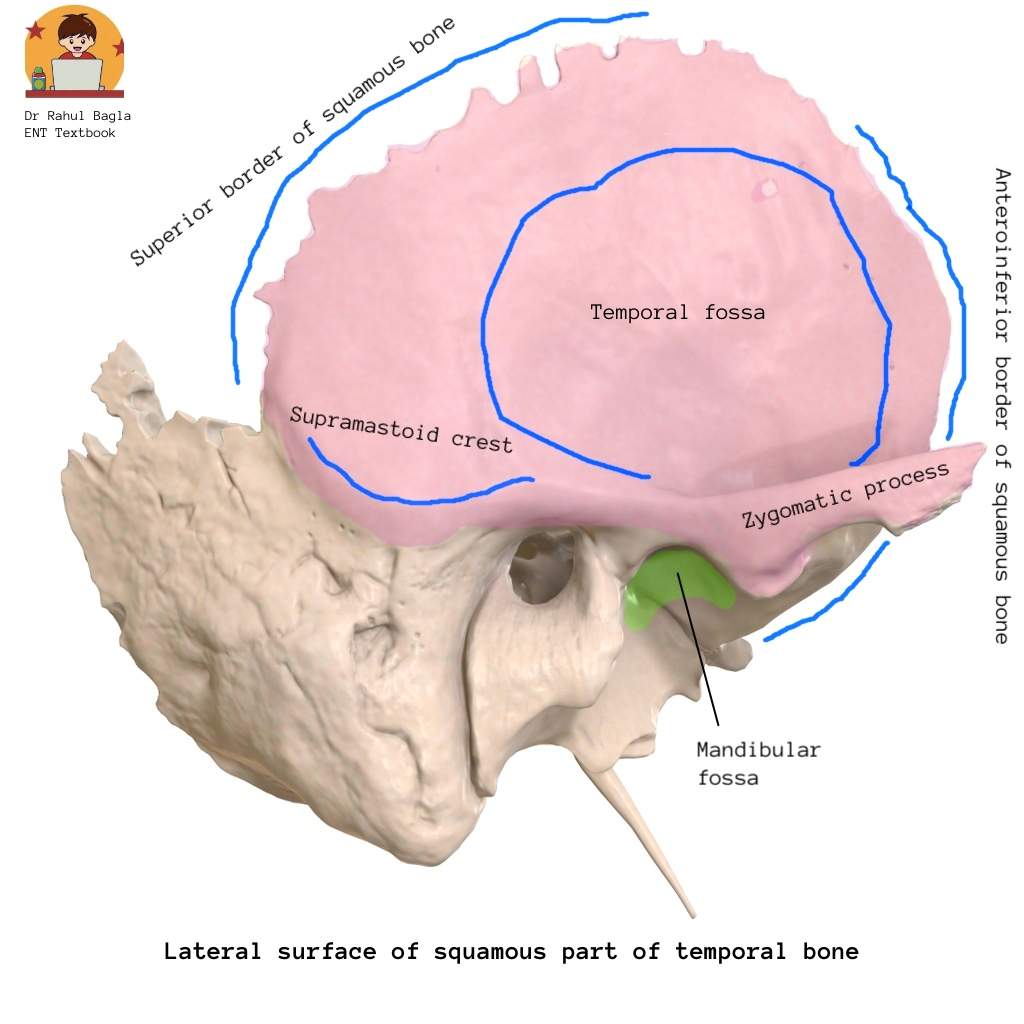
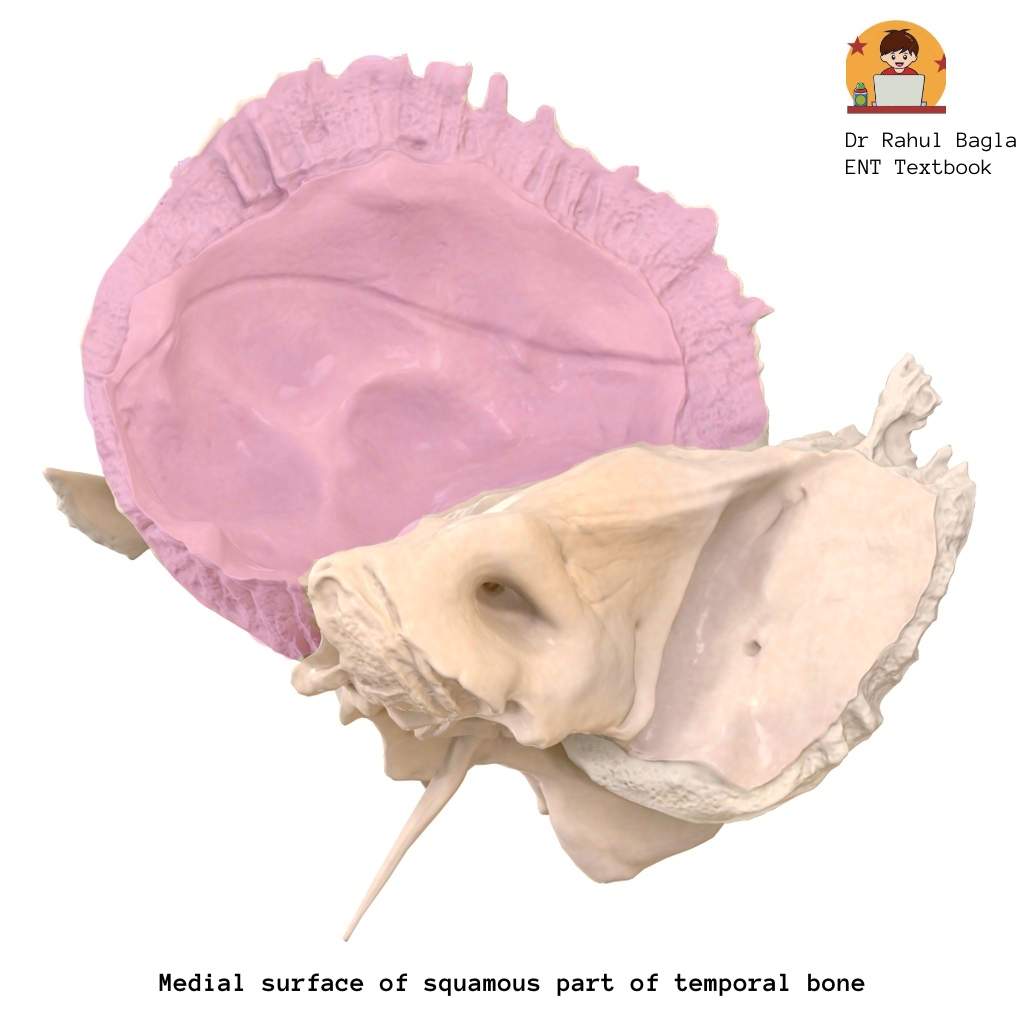
Relations of squamous temporal bone:
- Lateral surface (outer surface/ norma lateralis) – It is convex in shape and forms temporal fossa and temporalis muscle originates from here. Lateral surface is limited posteriorly by supramastoid crest which provide attachment to temporalis fascia. Squamous part is separated from mastoid part by an imaginary suture line which gets fused about 1.5 cm posterior to the supramastoid crest. Lateral surface also forms the roof and upper part of posterior external auditory canal (EAC), while the rest of the EAC is formed by tympanic part of temporal bone. On the lateral surface, the middle temporal artery runs in a groove.
- Medial surface (inner/ cerebral surface)– It is related with the temporal lobe of the brain. Anterior and posterior branches of the middle meningeal artery runs over it.
- Superior border – It articulates with inferior border of parietal skull bone.
- Anteroinferior border – It articulates with greater wing of sphenoid bone. It forms the posterolateral aspect of the infratemporal fossa.
- Zygomatic process – The zygomatic process projects from the lateral surface of squamous part of temporal surface and articulates with temporal process of the zygomatic bone to form zygomatic arch (palpable as ‘cheek bones’).
- Mandibular fossa is a depression which houses the synovial temporomandibular joint lies below the zygomatic process.
Petrous part of temporal bone.
Petrous (rock-like) part: It is located in the base of the skull between the sphenoid bone anteriorly and occipital bone posteriorly. It forms part of cranial floor and separates middle cranial fossa to posterior cranial fossa. It houses internal ear, middle ear and mastoid antrum, which it safely shields due to its high bone density. It also includes carotid canal for internal carotid artery.
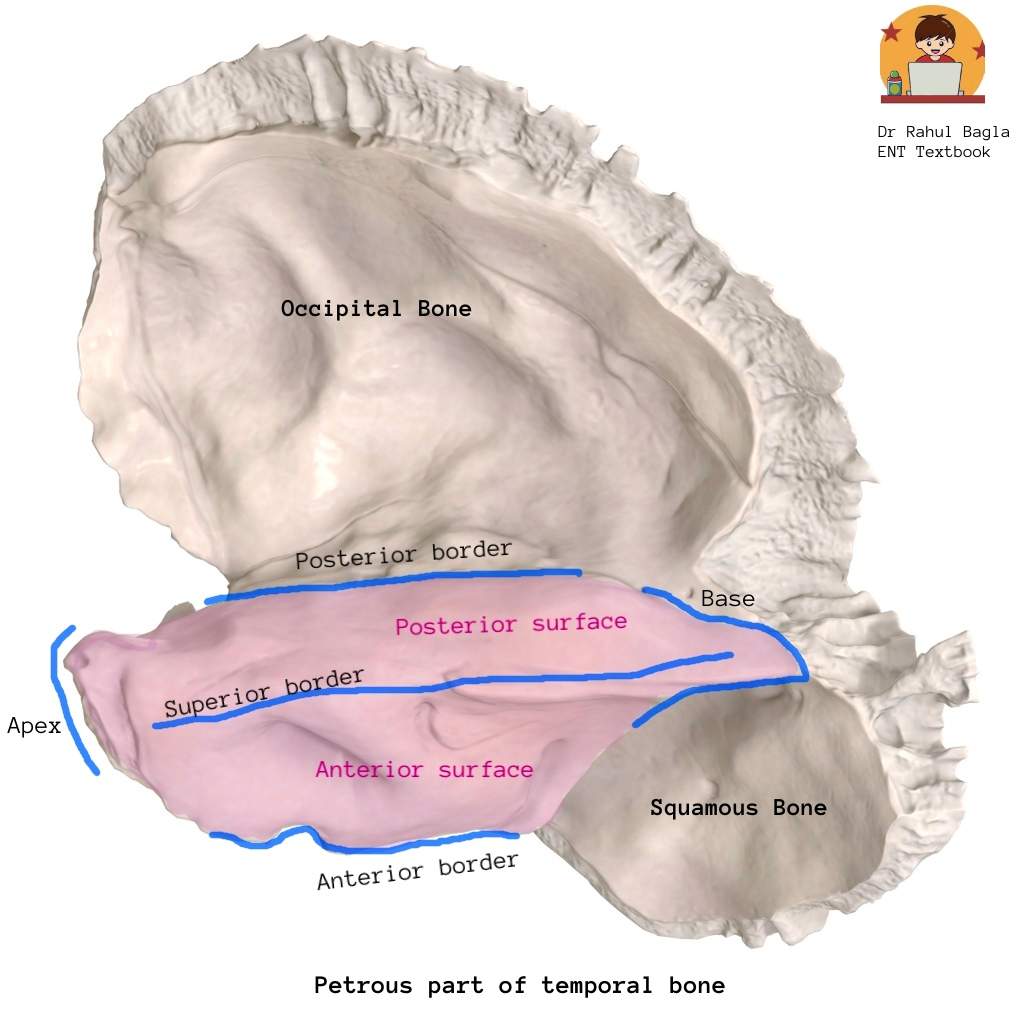
Boundaries of petrous part. It is a pyramid shaped structure, having a base, an apex, three surfaces (anterior, posterior, inferior) and three edges or margins (superior, anterior, posterior).
- Base – It is fused with the medial surface of the squamous part of the temporal bone and medial surface of the mastoid part of the temporal bone.
- Apex – It is directed forwards, upwards, medially towards body of sphenoid bone & greater wing of sphenoid bone, together making a lacerated foramen at the meeting point known as foramen lacerum. Apex forms the posterolateral margin of foramen lacerum. Apex also presents an internal opening of carotid canal which starts from the inferior surface of petrous part of temporal bone (outer opening of carotid canal). Carotid canal carries the petrous part of internal carotid artery.
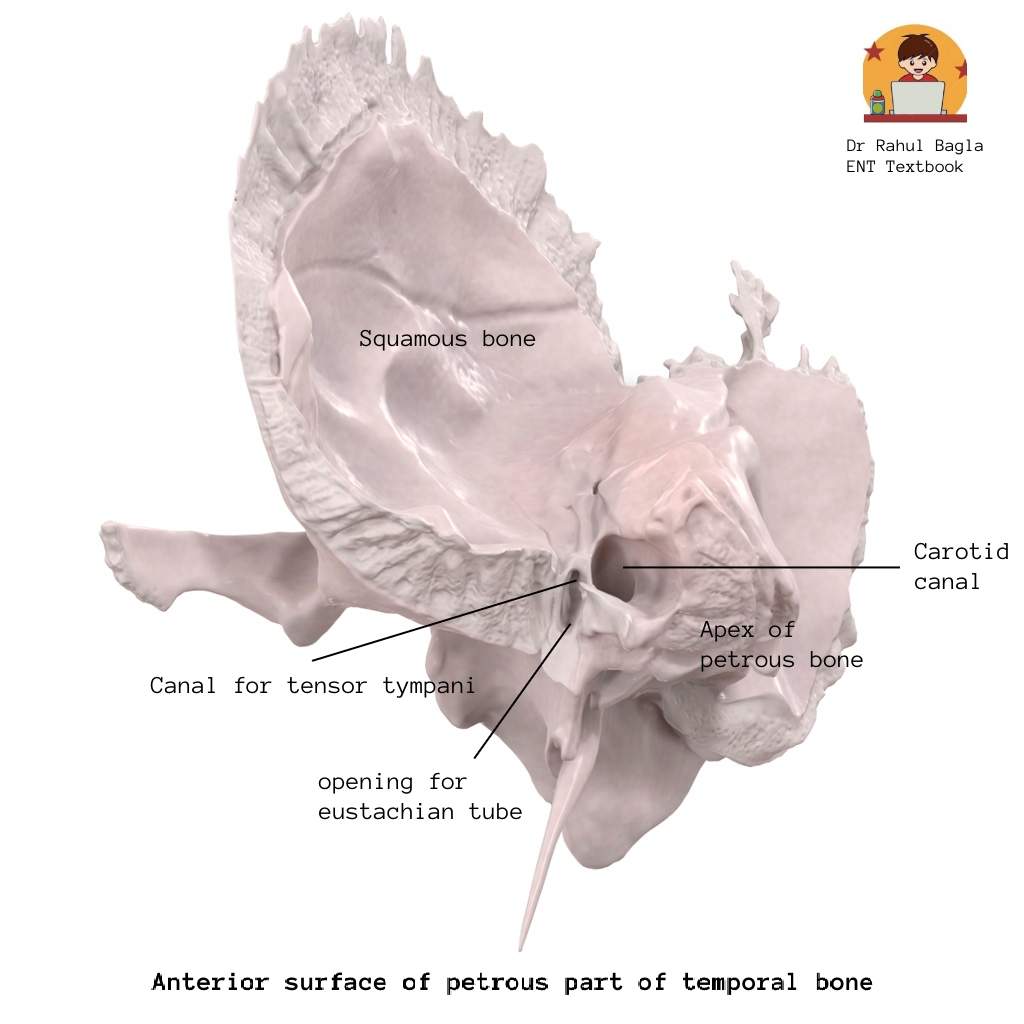

- Anterior surface – It forms the posterior wall of middle cranial fossa. It presents four important structures (medial to lateral) are trigeminal impression, roof of internal acoustic meatus, arcuate eminence, tegmen tympani. On the anterior surface close to the apex, there is trigeminal impression which lodges trigeminal ganglion. The depressed area, just lateral to the trigeminal impression is the roof of internal acoustic meatus. The elevated area, just lateral to the roof of internal acoustic meatus is the arcuate eminence, which is formed by underlying superior semicircular canal. Rest of the area lateral to the arcuate eminence towards the squamous part of temporal bone is the tegmen tympani. Running from medial to lateral, tegmen tympani forms the continuous roof of bony part of eustachian tube, middle ear cavity, aditus and mastoid antrum. Area of roof of middle ear cavity presents two hiatus for greater and lesser petrosal nerve. It also presents two openings, the canal for tensor tympani (upper one) and the opening of bony part of eustachian tube (lower one), both of which opens in the middle ear cavity.
- Posterior surface – It forms the anterior wall of the posterior cranial fossa. It presents an important structure, the opening of internal acoustic meatus. It is one cm is length and it is in line with the external auditory canal. The vestibulocochlear nerve, facial and labyrinthine artery enters from the medial opening of internal acoustic meatus (also known as porus)and passes through it. At the lateral opening of internal acoustic meatus (also known as fundus), the meatus is divided into upper and lower compartment by a bony plate, the ‘horizontal crest’.
- On the anterior aspect of upper compartment there is facial canal through which the facial nerve passes and on the posterior aspect there is superior vestibular area through which the superior division of vestibular nerve passes.
- On the anterior aspect of lower compartment there are spiral shape multiple foramina (known as tractor spiralis foraminosus) through which the cochlear nerve passes and on the posterior aspect there is inferior vestibular area through which the inferior division of vestibular nerve passes. On the most posterior aspect of lower compartment there is also a foramen singulare through which the branch of vestibular nerve passes which supply the ampulla of posterior semicircular canal.
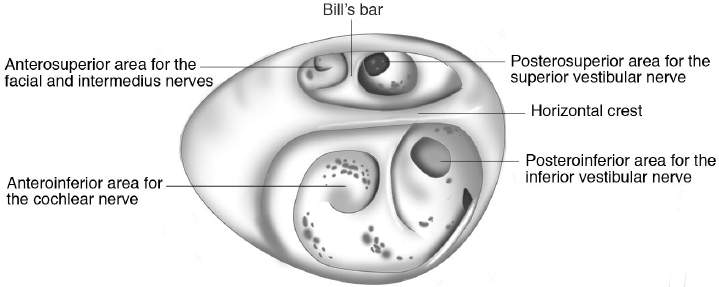
Lateral end of Internal acoustic meatus (Fundus)
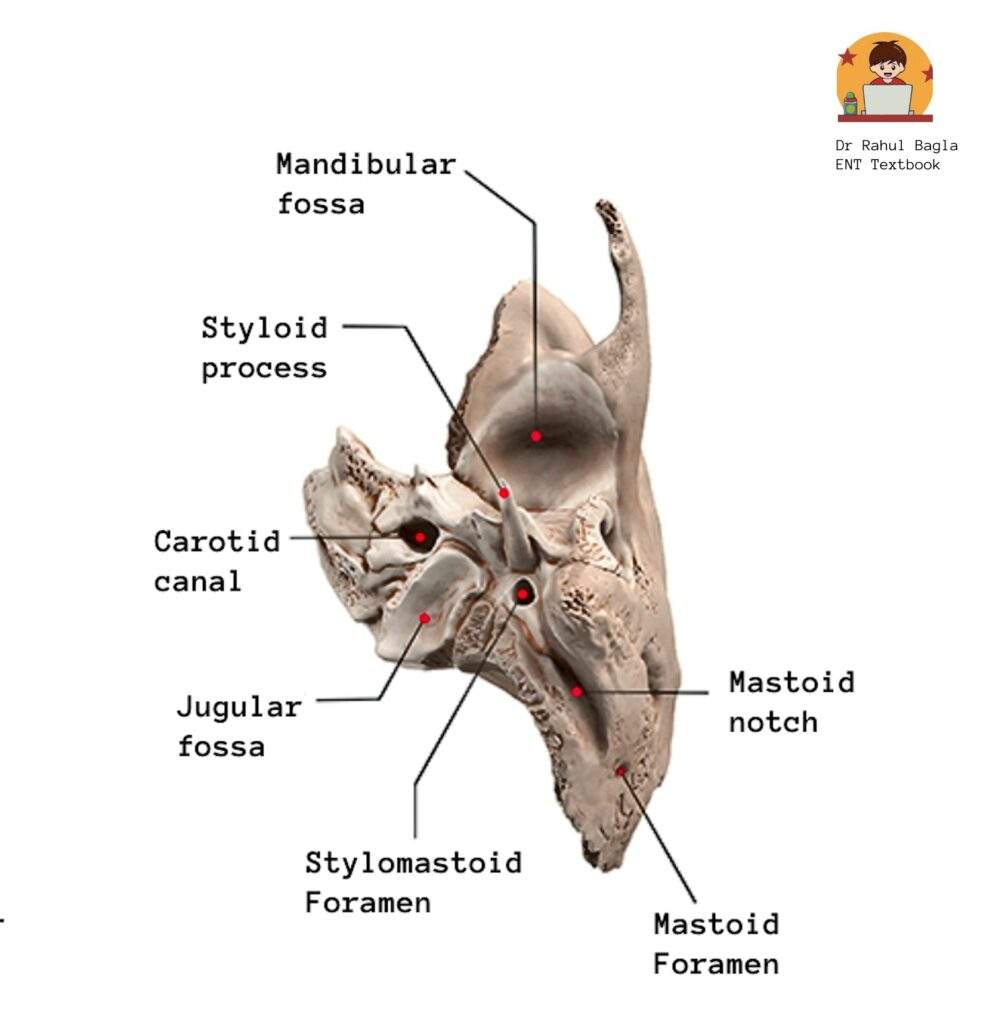
Inferior surface of petrous part of temporal bone
- Inferior surface – It is a quadrangular area viewed in the base of the skull. It is located between the occipital bone posteriorly and greater wing of sphenoid & squamous part anteriorly. Inferior surface presents the outer opening of the carotid canal. Lateral to the carotid canal lies the jugular fossa. Stylomastoid foramen is also present on the inferior surface through which facial nerve exit from the middle ear.
- Superior border – It is a long sharp crest which intervenes between middle and posterior cranial fossae. It provide attachment to tentorium cerebelli and it encloses the superior petrosal sinus.
- Anterior border – It can be divided into two parts. Medial part articulates with greater wing of sphenoid while the lateral part joins with the squamous part of temporal bone with a suture – petrosquamosal suture.
- Posterior border – It presents groove which lodges the inferior petrosal sinus. Its lateral part creates the superolateral boundary of the jugular foramen.
Mastoid part of temporal bone.
Mastoid part: It is situated posterior to the squamous part of temporal bone and separates from it by an imaginary suture line which gets fused about 1.5 cm posterior to the supra-mastoid crest. Mastoid part of temporal bone includes mastoid antrum and its air cells, which communicate with the middle ear cavity. It is formed by squamous part of temporal bone (laterally) and a petrous part of temporal bone (medially) separated by Korner’s (petrosquamous) septum. It has two surfaces and two borders:
- Lateral surface is continuous with mastoid process which provide attachment of sternocleidomastoid, splenius capitis and longissimus capitis muscles. Mastoid process is present just posterior to the external auditory canal opening and it is not fully developed in children. A more horizontal postauricular incision should be given to prevent injury to the facial nerve.
- Medial/ inner surface of the mastoid part of temporal bone forms the sigmoid sulcus which lodges sigmoid sinus. Medial surface is further continuous with posterior surface of petrous part of temporal bone. Whereas the medial surface of the mastoid process which is present inferior to the mastoid part of temporal bone, presents a digastric notch which presents attachment to the posterior belly of digastric muscle. Groove for occipital artery lies medial to digastric notch. The mastoid foramen, is also present on the medial surface of mastoid process, which is passed by the mastoid emissary vein for venous drainage and one or two mastoid arteries.
- Superior border articulates with the inferior border of parietal bone forming parietomastoid suture.
- Posterior border articulates with the occipital bone forming occipitomastoid suture.
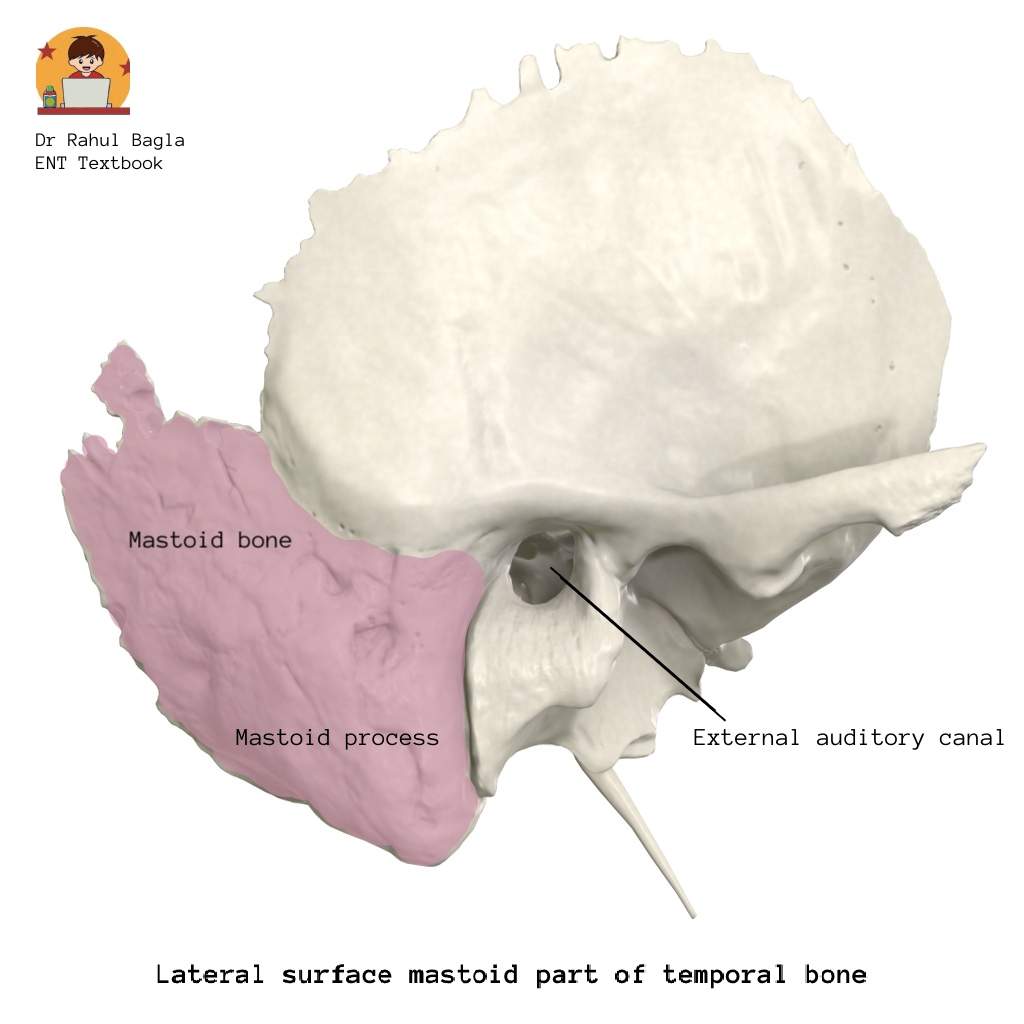
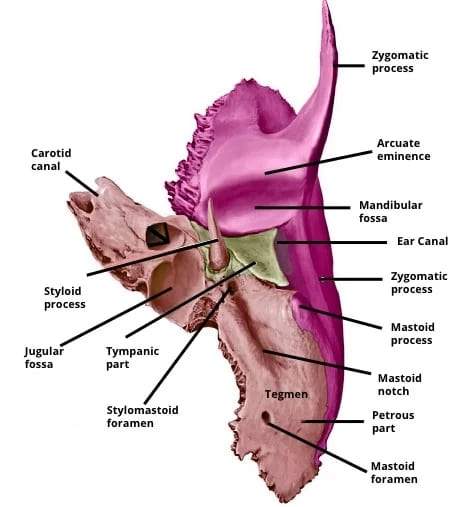
Medial and Inferior surface of mastoid part of temporal bone
The mastoid part of temporal bone, parietal and occipital bones meet at a point to form asterion.
Tympanic part of temporal bone.
Tympanic part is situated lateral to the petrous part of temporal bone, inferiorly to the squamous part of temporal bone, and anteriorly to the mastoid part of temporal bone. Tympanic part is attached to squamous part and mastoid part forming the tympanosquamous anteriorly and tympanomastoid sutures posteriorly. It is a triangular bony plate. It has three borders (superior, inferior & lateral) and two surfaces (anterior & posterior):
Relations of tympanic part of temporal bone:
- Superior border is related to mandibular fossa.
- Inferior border is related to styloid process and inferior aspect of petrous part of temporal bone.
- Lateral border along with the posterior surface forms anterior wall, the floor and lower part of the posterior wall of the bony ear canal. Tympanic bone boundary ends at the cartilaginous EAC.
- Anterior surface is related to parotid gland & mandibular fossa.
- Posterior surface, it bears a circular groove tympanic sulcus (annular sulcus) for the attachment of the tympanic membrane.
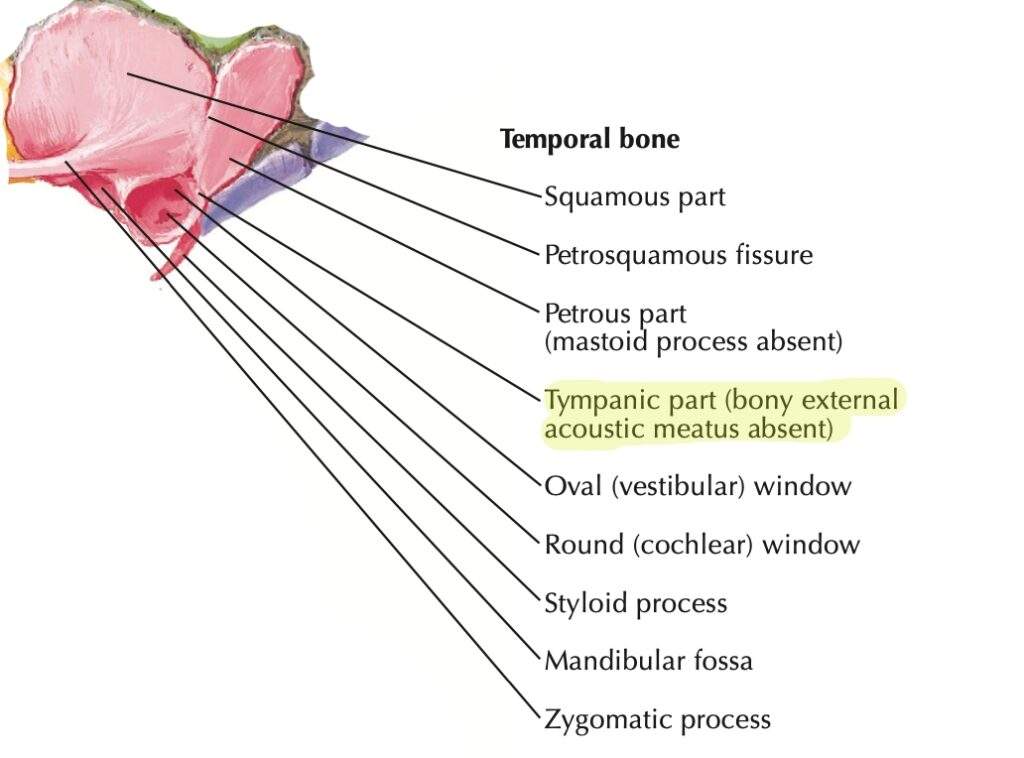
Chorda tympani, anterior tympanic artery and anterior process of malleus traverses the petrotympanic fissure. Arnold’s nerve traverses tympanomastoid suture. The inferior aspect of the tympanomastoid suture line is an important operative landmark for identifying the facial nerve as it exits the stylomastoid foramen.
Styloid part of temporal bone.
Styloid process is a long, slender, pointed piece of bone originating from the inferior aspect of the fusion of the tympanic and petrous bones and located in front of the jugular fossa. Its normal length is approximately 2.5 cm. It projects downwards, forwards and medially, giving attachment to several muscles and ligaments.
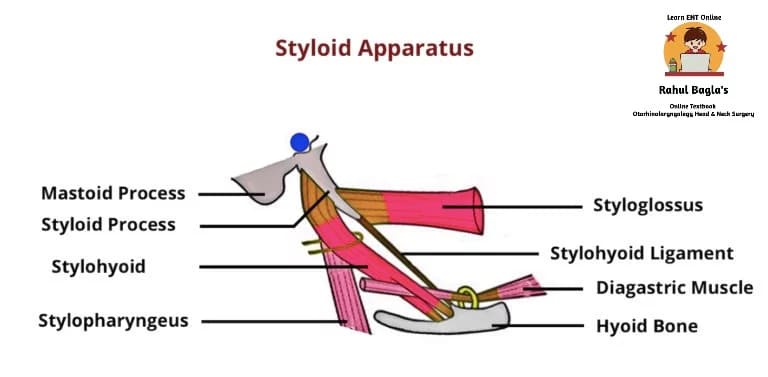
- Ligaments – Stylohyoid, stylomandibular
- Muscles – Styloglossus, stylohyoid, stylopharyngeus.
Styloglossus is supplied by hypoglossal nerve, stylohyoid is supplied by facial nerve, stylopharyngeus is supplied by glossopharangeal nerve.
Stylomandibular ligament extends from anterior surface of apex of styloid process to the posterior surface of the angle of mandible. This ligament separates parotid gland from submandibular gland & medial pterygoid muscle.
The stylomastoid foramen is a round opening situated between the styloid and the mastoid processes. It transmits the facial nerve (CN VII) and the stylomastoid artery.
—— End of the chapter ——
Anatomy of Temporal Bone Anatomy of Temporal Bone Anatomy of Temporal Bone Anatomy of Temporal Bone Anatomy of Temporal Bone, Anatomy of Temporal Bone, Anatomy of Temporal Bone, Anatomy of Temporal Bone, Anatomy of Temporal Bone, Anatomy of Temporal Bone, Anatomy of Temporal Bone, Anatomy of Temporal Bone, Anatomy of Temporal Bone, Anatomy of Temporal Bone
-
Follow our Facebook page: https://www.facebook.com/Dr.Rahul.Bagla.UCMS
-
Join our Facebook group: https://www.facebook.com/groups/628414274439500
-
Read chapter Glomus Tumour. https://www.entlecture.com/glomus-tumour/
Learning resources.
- Scott-Brown, Textbook of Otorhinolaryngology Head and Neck Surgery.
- Glasscock-Shambaugh, Textbook of Surgery of the Ear.
- Susan Standring, Gray’s Anatomy.
- Logan Turner, Textbook of Diseases of The Nose, Throat and Ear Head and Neck Surgery.
- P L Dhingra, Textbook of Diseases of Ear, Nose and Throat.
- Hazarika P, Textbook of Ear Nose Throat and Head Neck Surgery Clinical Practical.
- Mohan Bansal, Textbook of Diseases of Ear, Nose and Throat Head and Neck surgery.
Author:

Dr. Rahul Kumar Bagla
MS & Fellow Rhinoplasty & Facial Plastic Surgery.
Associate Professor & Head
GIMS, Greater Noida, India
msrahulbagla@gmail.com
Please read. Glomus Tumour. https://www.entlecture.com/glomus-tumour/
Follow our Facebook page: https://www.facebook.com/Dr.Rahul.Bagla.UCMS
Join our Facebook group: https://www.facebook.com/groups/628414274439500
